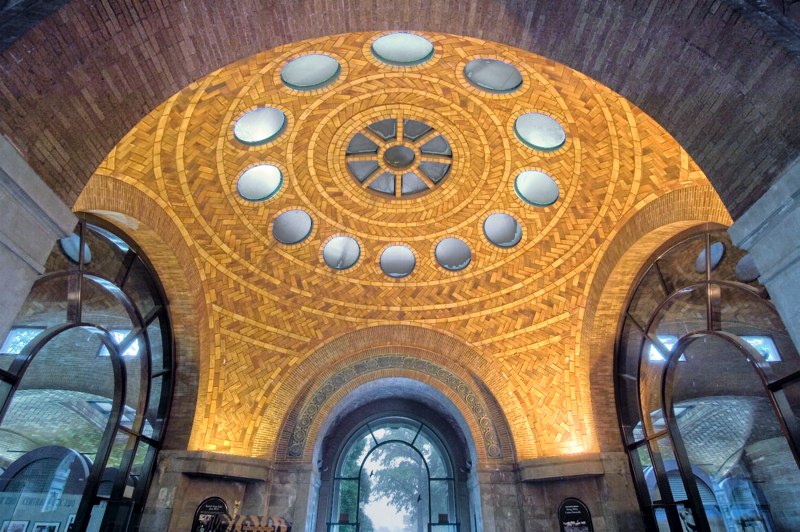by: Camila Schaulson Frenz
“What do Carnegie Hall, the Cathedral of Saint John the Divine, Grand Central Station, Grant’s Tomb and the Bronx Zoo’s Elephant House have in common?” At first, this question, asked by WNYC’s Leonard Lopate at The Greene Space’s conversation “Guastavino in New York” may stump even the most inveterate New Yorker. The answer, however – the presence of tile vaulting by Spanish architect Rafael Guastavino – is, according to Jill Lerner, principal at KPF and immediate past-president of AIANY, something that New Yorkers are always “subconsciously aware of.”
The prolific work of the Guastavino Fireproof Construction Company in New York City is the subject of an upcoming exhibition at the Museum of the City of New York, Palaces for the People: Guastavino and the Art of Structural Tile. According to John Ochsendorf, MacArthur Fellow and Professor of Civil and Environmental Engineering and Architecture at MIT and curator of the exhibition, New York City is at the center of the Guastavino universe. There are over 250 documented projects by the Spanish architect, and a new building is discovered every couple of weeks. Ochsendorf promises to buy lunch for anyone who claims to have discovered an undocumented Guastavino.
Guastavino’s name often goes unnoticed, as his Catalan vaults grace structures by some of the period’s most renowned architects, including the empire of McKim, Mead and White but remain uncredited. However, the architects of major Beaux Arts buildings allowed Guastavino tremendous design freedom, often leaving entire sections of their plans empty, except for the words “Guastavino here.”
By the time of Guastavino Sr.’s death in 1908, his company was working on 100 buildings at a time. Guastavino’s son, who had apprenticed under his father much in the same style as Gothic master masons, took over the company and created some of its most iconic works, including the Oyster Bar and Whispering Gallery at Grand Central Station. The success of the father and son team had as much to do with their stunning work as with opportune timing and strategic business moves. Guastavino arrived in New York (speaking little English) before the arrival of reinforced concrete and steel and patented the Catalan vault, in what proved to be a brilliant business move.
The vaults themselves are engineering masterpieces, resulting in an astonishing “blend of art and technology,” according to Lerner. Most of the structures have no steel components, and engineers working with Ochsendorf at MIT have struggled with how they actually stand. According to hi-tech computer models, they shouldn’t, but Ochsendorf stands by the master builder and the test of time: “It’s not the staircase that’s wrong.” Ochsendorf went on to tell the story of one such building, which sat abandoned for over 40 years. In order to determine its stability, each one of its 30,000 tiles were hit with a rubber mallet. Only 11 had to be replaced. To architect Santiago Calatrava, the work of his fellow Spaniard is a “maestria”. He likened the strength of the Guastavino vault to an eggshell, which is surprisingly hard to crush with one hand. Ochsendorf stepped in, adding that Guastavino’s vaults are proportionally even thinner than eggshells.
Despite their beauty and technological innovation, the decline of Guastavino’s work was almost inevitable, with changing architectural styles, the rise of the industrial aesthetic, and the arrival of thin concrete shells making his work appear antiquated. In the 1960’s, Columbia Professor George Collins saved the Guastavino Fireproof Construction Company’s archives from a dumpster. Before being designated a New York City Landmark in 1973, the areas before the 59th Street Bridge were used for parking.
While Calatrava laments the loss of “the craft of the hand,” the work of Guastavino reminds us of the importance of “celebrating the people with public spaces that are interesting and unusual.” The legacy of Guastavino’s beautiful public spaces lives on in “Palaces for the People: Guastavino and the Art of Strucutral Tile.” Lerner, one of the exhibition’s co-chairs, stated, “I hope the Guastavino exhibition at the Museum of the City of New York will inspire architects to make dignified spaces for people.” And to Ochsendorf, it offers New Yorkers a chance to correct an oversight: “Like America, Guastavino needs to be rediscovered” – or at least brought out from the recesses of our subconscious. With increased awareness of his impact in New York City and all over the country, there may be a day where more New Yorkers see the Spanish architect like Ochsendorf does, who ended the conversation by stating, “I think of Guastavino as an old friend. I walk around New York, look up, and say, ‘Ah, Rafael was here.’”
The openings of “Palaces for the People: Guastavino and the Art of Strucutral Tile” at the Museum of the City of New York on 03.26.14 and “Polis: 7 Lessons from the European Prize for Urban Public Space [2000-2012],” a retrospective from the Center for Contemporary Culture of Barcelona, on 03.27.14 give us insight into the uncanny link between two cities: Barcelona and New York. Stay tuned to our calendar to learn more about related programs for both.
Event: Guastavino in New York
Location: The Greene Space, 02.25.14
Speakers: Leonard Lopate, WNYC; Santiago Calatrava, Architect; John Ochsendorf, MacArthur Fellow and Professor of Civil and Environmental Engineering and Architecture, MIT; and Jill Lerner, FAIA, Principal, Kohn Pedersen Fox Associates
Organizers: Museum of the City of New York
Co-Sponsor: AIA New York Chapter
Supporter: JL Greene











